Synthesis and Biological Evaluation of Desacetylmatricarin Derivatives Isolated from Basin Big Sagebrush
Abstract
:1. Introduction
2. Materials and Methods
2.1. Materials
2.2. Methods
2.2.1. Extraction and Purification of Desacetylmatricarin from Plant Materials
2.2.2. General Procedure for the Preparation of Desacetylmatricarin Derivatives (3a–3i)
2.2.3. National Cancer Institute (NCI)-60 Cell Line Evaluation
3. Results and Discussion
4. Conclusions

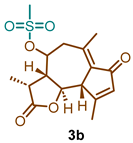

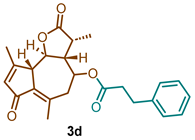
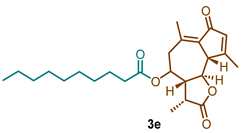
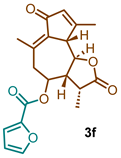
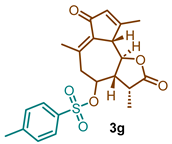
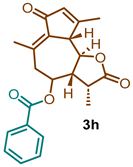

Supplementary Materials
Author Contributions
Funding
Data Availability Statement
Acknowledgments
Conflicts of Interest
References
- Dhyani, P.; Sati, P.; Sharma, E.; Attri, D.C.; Bahukhandi, A.; Tynybekov, B.; Szopa, A.; Sharifi-Rad, J.; Calina, D.; Suleria, H.A.R.; et al. Sesquiterpenoid lactones as potential anti-cancer agents: An update on molecular mechanisms and recent studies. Cancer Cell Int. 2022, 22, 305. [Google Scholar] [CrossRef] [PubMed]
- Paço, A.; Brás, T.; Santos, J.O.; Sampaio, P.; Gomes, A.C.; Duarte, M.F. Anti-Inflammatory and Immunoregulatory Action of Sesquiterpene Lactones. Molecules 2022, 27, 1142. [Google Scholar] [CrossRef] [PubMed]
- Nkeh, B.C.-A.; Njamen, D.; Wandji, J.; Fomum, Z.T.; Dongmo, A.; Nguelefack, T.B.; Wansi, D.; Kamanyi, A. Anti-inflammatory and Analgesic Effects of Drypemolundein A, a Sesquiterpene Lactone from Drypetes molunduana. Pharm. Biol. 2003, 41, 26–30. [Google Scholar] [CrossRef]
- de Almeida, A.B.A.; Luiz-Ferreira, A.; Cola, M.; Magri, L.D.P.; Batista, L.M.; de Paiva, J.A.; Trigo, J.R.; Souza-Brito, A.R. Anti-Ulcerogenic Mechanisms of the Sesquiterpene Lactone Onopordopicrin-Enriched Fraction from Arctium lappa L. (Asteraceae): Role of Somatostatin, Gastrin, and Endogenous Sulfhydryls and Nitric Oxide. J. Med. Food 2012, 15, 378–383. [Google Scholar] [CrossRef] [PubMed]
- Cimmino, A.; Roscetto, E.; Masi, M.; Tuzi, A.; RadJai, I.; Gahdab, C.; Paolillo, R.; Guarino, A.; Catania, M.R.; Evidente, A. Sesquiterpene Lactones from Cotula cinerea with Antibiotic Activity against Clinical Isolates of Enterococcus faecalis. Antibiotics 2021, 10, 819. [Google Scholar] [CrossRef] [PubMed]
- Barrero, A.F.; Oltra, J.; Álvarez, M.; Raslan, D.S.; Saúde, D.A.; Akssira, M. New sources and antifungal activity of sesquiterpene lactones. Fitoterapia 2000, 71, 60–64. [Google Scholar] [CrossRef] [PubMed]
- Özçelik, B.; Gürbüz, I.; Karaoglu, T.; Yeşilada, E. Antiviral and antimicrobial activities of three sesquiterpene lactones from Centaurea solstitialis L. ssp. solstitialis. Microbiol. Res. 2009, 164, 545–552. [Google Scholar] [CrossRef]
- Laurella, L.C.; Cerny, N.; Bivona, A.E.; Alberti, A.S.; Giberti, G.; Malchiodi, E.L.; Martino, V.S.; Catalan, C.A.; Alonso, M.R.; Cazorla, S.I.; et al. Assessment of sesquiterpene lactones isolated from Mikania plants species for their potential efficacy against Trypanosoma cruzi and Leishmania sp. PLoS Negl. Trop. Dis. 2017, 11, e0005929. [Google Scholar] [CrossRef] [PubMed]
- Wu, H.-B.; Wang, W.-S.; Liu, T.-T.; Qi, M.-G.; Feng, J.-C.; Li, X.-Y.; Liu, Y. Insecticidal activity of sesquiterpene lactones and monoterpenoid from the fruits of Carpesium abrotanoides. Ind. Crop. Prod. 2016, 92, 77–83. [Google Scholar] [CrossRef]
- Chadwick, M.; Trewin, H.; Gawthrop, F.; Wagstaff, C. Sesquiterpenoids Lactones: Benefits to plants and people. Int. J. Mol. Sci. 2013, 14, 12780–12805. [Google Scholar] [CrossRef]
- Ivanescu, B.; Miron, A.; Corciova, A. Sesquiterpene Lactones from Artemisia Genus: Biological Activities and Methods of Analysis. J. Anal. Methods Chem. 2015, 2015, 247685. [Google Scholar] [CrossRef] [PubMed]
- Revazova, L.V.; Chugunov, P.V.; Pakaln, D.A. Desacetylmatricarin from Artemisia incana. Chem. Nat. Compd. 1970, 6, 377. [Google Scholar] [CrossRef]
- Lee, K.; Simpson, R.; Geissman, T. Sesquiterpenoid lactones of Artemisia. Constituents of Artemisia cana ssp. Cana. the structure of Canin. Phytochemistry 1969, 8, 1515–1521. [Google Scholar] [CrossRef]
- Anibogwu, R.; De Jesus, K.; Pradhan, S.; Van Leuven, S.; Sharma, K. Sesquiterpene Lactones and Flavonoid from the Leaves of Basin Big Sagebrush (Artemisia tridentata subsp. tridentata): Isolation, Characterization and Biological Activities. Molecules 2024, 29, 802. [Google Scholar] [CrossRef]
- Ho, C.; Choi, E.J.; Yoo, G.S.; Kim, K.-M.; Ryu, S.Y. Desacetylmatricarin, an Anti-Allergic Component from Taraxacum platycarpum. Planta Med. 1998, 64, 577–578. [Google Scholar] [CrossRef] [PubMed]
- Shah, S.; Ali, Z.; Malik, A.; Khan, I.A.; Saied, S. Sesquiterpene Lactones from Cichorium intybus. Z. Naturforschung Sect. B-A J. Chem. Sci. 2011, 66, 729–732. [Google Scholar] [CrossRef]
- Glasl, S.; Mucaji, P.; Werner, I.; Presser, A.; Jurenitsch, J. Sesquiterpenes and Flavonoid Aglycones from a Hungarian Taxon of the Achillea millefolium Group. Z. Naturforschung Sect. C-A J. Biosci. 2002, 57, 976–982. [Google Scholar] [CrossRef] [PubMed]
- Anibogwu, R.; De Jesus, K.; Pradhan, S.; Pashikanti, S.; Mateen, S.; Sharma, K. Extraction, Isolation and Characterization of Bioactive Compounds from Artemisia and Their Biological Significance: A Review. Molecules 2021, 26, 6995. [Google Scholar] [CrossRef] [PubMed]
- Xiong, Y.; Huang, J. Anti-malarial drug: The emerging role of artemisinin and its derivatives in liver disease treatment. Chin. Med. 2021, 16, 80. [Google Scholar] [CrossRef]
- NCI-60 Screening Methodology|NCI-60 Human Tumor Cell Lines Screen|Discovery & Development Services|Developmental Therapeutics Program (DTP). Available online: https://dtp.cancer.gov/discovery_development/nci-60/methodology.htm (accessed on 23 June 2022).
- Abu-Izneid, T.; Rauf, A.; Shariati, M.A.; Khalil, A.A.; Imran, M.; Rebezov, M.; Uddin, S.; Mahomoodally, M.F.; Rengasamy, K.R. Sesquiterpenes and their derivatives-natural anticancer compounds: An update. Pharmacol. Res. 2020, 161, 105165. [Google Scholar] [CrossRef]
- Laurella, L.C.; Mirakian, N.T.; Garcia, M.N.; Grasso, D.H.; Sülsen, V.P.; Papademetrio, D.L. Sesquiterpene Lactones as Promising Candidates for Cancer Therapy: Focus on Pancreatic Cancer. Molecules 2022, 27, 3492. [Google Scholar] [CrossRef] [PubMed]
- Verma, S.S.; Rai, V.; Awasthee, N.; Dhasmana, A.; RaJalaksmi, D.S.; Nair, M.S.; Gupta, S.C. Isodeoxyelephantopin, a sesquiterpene lactone induces ROS generation, suppresses NF-ΚB activation, modulates LNCRNA expression and exhibit activities against breast cancer. Sci. Rep. 2019, 9, 17980. [Google Scholar] [CrossRef] [PubMed]
- Li, M.; Song, L.-H.; Yue, G.G.-L.; Lee, J.K.-M.; Zhao, L.-M.; Li, L.; Zhou, X.; Tsui, S.K.-W.; Ng, S.S.-M.; Fung, K.-P.; et al. Bigelovin triggered apoptosis in colorectal cancer in vitro and in vivo via upregulating death receptor 5 and reactive oxidative species. Sci. Rep. 2017, 7, srep42176. [Google Scholar] [CrossRef] [PubMed]
- Boulos, J.C.; Omer, E.A.; Rigano, D.; Formisano, C.; Chatterjee, M.; Leich, E.; Klauck, S.M.; Shan, L.-T.; Efferth, T. Cynaropicrin disrupts tubulin and c-Myc-related signaling and induces parthanatos-type cell death in multiple myeloma. Acta Pharmacol. Sin. 2023, 44, 2265–2281. [Google Scholar] [CrossRef] [PubMed]

Disclaimer/Publisher’s Note: The statements, opinions and data contained in all publications are solely those of the individual author(s) and contributor(s) and not of MDPI and/or the editor(s). MDPI and/or the editor(s) disclaim responsibility for any injury to people or property resulting from any ideas, methods, instructions or products referred to in the content. |
© 2024 by the authors. Licensee MDPI, Basel, Switzerland. This article is an open access article distributed under the terms and conditions of the Creative Commons Attribution (CC BY) license (https://creativecommons.org/licenses/by/4.0/).
Share and Cite
Paucar, N.E.; Leuven, S.V.; Jesus, K.D.; Pashikanti, S.; Mateen, S.; Pradhan, S.; Sharma, K. Synthesis and Biological Evaluation of Desacetylmatricarin Derivatives Isolated from Basin Big Sagebrush. Separations 2024, 11, 217. https://doi.org/10.3390/separations11070217
Paucar NE, Leuven SV, Jesus KD, Pashikanti S, Mateen S, Pradhan S, Sharma K. Synthesis and Biological Evaluation of Desacetylmatricarin Derivatives Isolated from Basin Big Sagebrush. Separations. 2024; 11(7):217. https://doi.org/10.3390/separations11070217
Chicago/Turabian StylePaucar, N. Evelin, Shanae Van Leuven, Karl De Jesus, Srinath Pashikanti, Sameena Mateen, Samjhana Pradhan, and Kavita Sharma. 2024. "Synthesis and Biological Evaluation of Desacetylmatricarin Derivatives Isolated from Basin Big Sagebrush" Separations 11, no. 7: 217. https://doi.org/10.3390/separations11070217




